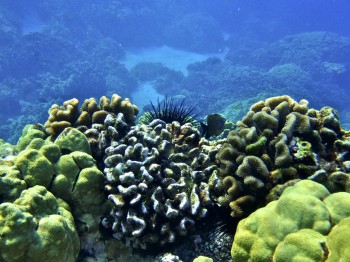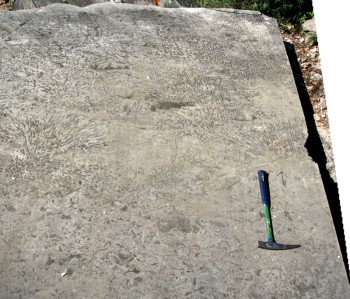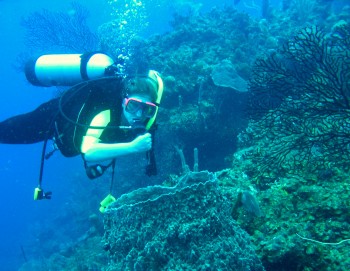Extinction Detective: Rowan Martindale Investigates the Fates of Ancient Reefs
December 31, 2013

Growing up amid the crisp, cold landscape of the Canadian Rockies, Rowan Martindale’s family liked to vacation in tropical environs with warm waters. As a result, the high-country farm girl learned to snorkel and scuba dive and explored coral reefs at an early age. Now, through her studies of ancient reefs, Martindale, an assistant professor in the Jackson School of Geosciences, is helping us understand the potential effects of the looming environmental threat from ocean acidification.
“I like reef ecosystems because you’re not just looking at one thing,” Martindale says. “You have to understand how the organisms building the reef work. You have to understand the oceanography and the chemistry. You have to look at the whole ecosystem which I find really exciting.”
Coral reefs are sometimes called the rainforests of the sea. The fragile underwater environments, composed of animals and plants encased in calcium carbonate skeletons, cover just a tiny fraction of the planet, yet provide habitat for one-fourth of all marine species. But ocean acidification – a drop in ocean pH caused by an increase in carbon dioxide levels – threatens reefs’ ability to sustain and rebuild themselves, which can trigger a crash in these essential marine environments. Concerns over current ocean acidification, related to greenhouse gas emissions, have generated plenty of research of ongoing shifts in the seas, but Martindale is looking back in time to provide answers about acidification, reef extinctions, and other impacts.
“There’s been a lot of research on modern ocean acidification and looking at how different organisms respond,” Martindale says, “but when you go into the rock record, especially in really deep time, there are very few tools that you can use to say whether ocean acidification occurred.”

Martindale grew up just outside Calgary, Alberta, and was interested in Albertan fossils from an early age. At Queen’s University in Kingston, Ontario, Canada, she studied biology, but her interests in big-picture questions about evolution and species extinction led her to pursue a major in geology. Her undergraduate research thesis looked at cool-water carbonates and sediments around the island of Tasmania.
Looking to bring together her experience and interests in carbonate sedimentology, reef ecology, and environmental science, Martindale went to work on her Ph.D. at the University of Southern California. With input from her adviser, paleoecologist David Bottjer, she decided to study reefs and carbonates dating from the Late Triassic period, over 200 million years ago. During the Late Triassic, the supercontinent Pangaea made up the planet’s landmass, there was no Atlantic Ocean, climates were much warmer and dinosaurs were beginning to take over the land.
Researchers previously thought North American Triassic reefs mostly existed as deeper water, tropical coral systems, but Martindale says her study sites in British Columbia, Oregon, and Nevada show that the prehistoric reefs grew along a thermal gradient, in both warm and cool, shallow waters. In the temperate systems, Martindale found that microbes, small organisms, and sponges – often overshadowed by the visually stunning corals – played important roles in nutrient cycling and reef construction.
“Surprisingly little work had been done, especially in North America, on Triassic reefs, and I realized there was a lot more nuance to their ecology,” she says. “When you look under the microscope, each reef is unique.”
She conducted similar work in the Austrian Alps where “The Sound of Music” was filmed.

While 200 million years separate the Triassic from current times, Martindale says the ancient reefs have important ties to the modern ocean. Specifically, the Triassic marks the appearance of the ancestors of today’s coral species, which built reefs together with sponges, and algae, in a similar way to their modern descendants. By studying the prehistoric and present conditions and changes, Martindale says, “We can use the past to tell us about the present.”
That connection is particularly significant since the end of the Triassic was marked by a catastrophic mass extinction 201 million years ago. One of the planet’s five mega-extinction events, scientists believe about three quarters of the planet’s species were wiped out at the time. The oceans, Martindale says, suffered “one of the biggest reef collapses and the most severe extinction of modern corals.”
The most accepted cause of the Triassic-Jurassic mass extinction is a series of massive volcanic eruptions, which would have released a sudden “burp” of carbon dioxide and other greenhouse gases – like we’re experiencing today. Some investigators have also suggested ocean acidification was a factor, but there’s less consensus on that point.
“It’s one of the few times in geological history,” Martindale says of the Late Triassic event, “where we might have an analog for what’s going on in the modern ocean.”
As part of her doctoral research, Martindale and colleagues gathered findings from volcanologists, sedimentologists, and climatologists who have studied the Triassic-Jurassic event. By reviewing measurements of climate and carbon dioxide concentrations, ocean carbonate sediments, the timing and size of eruptions, and records of the land and marine species that went extinct, the scholars recognized a surprising drop in ocean carbonate sediments and organisms with a carbonate skeleton at the extinction. That led Martindale and her colleagues to conclude that ocean acidification likely occurred as a product of the volcanic eruptions at the Triassic-Jurassic boundary and is “a reasonable explanation for why the extinction was so severe.”

After completing her Ph.D, Martindale landed a postdoctoral position working with Dr. Andrew Knoll at Harvard University following up on her studies of reef paleoecology. She comes to Austin having turned her attention to other extinction events, the impacts on reefs, and the connections with ocean acidification.
“There are still a lot of time periods where very little research has been done,” Martindale says.
Martindale is now studying the Pliensbachian-Toarcian, a more moderate extinction event about 183 million years ago, during the Early Jurassic Period. Similar to the older Triassic mass extinction, geoscientists attribute the turnover to volcanic eruptions. Indeed, there is evidence of warmer temperatures, lower oxygen in the ocean, and reef collapse, yet fewer organisms and species were killed off.
“Our hypothesis is this may have been an ocean acidification event as well, but first we have to find evidence of acidification,” Martindale says. “People have suggested it might be, but no one has gone in and done the legwork. We plan to look at the geochemical proxies and the ecology of the reefs to see how they changed through time.”
Before settling in at the Jackson School, Martindale has been carrying out field research in Morocco, Slovenia, Italy, and even back in Alberta, Canada, to study early Toarcian sites. If her hypothesis holds up, Martindale will face another major research question: If it was an acidification event, why wasn’t this a mass extinction and why did so many species survive?
With a research field that relies on disciplines from sedimentology to geochemistry, Martindale looks forward to pursuing her work in collaboration with fellow Jackson School colleagues. She plans to team up with UT geochemists, paleontologists, sedimentologists, and other scientists, and, she adds, “It doesn’t hurt that we have (almost) every instrument under the sun.” Martindale also expects to study local Permian reefs in Texas, giving her a much older class of sites to explore.
Ultimately, her inquiries into reef paleoecology, carbonate sedimentology, and ocean acidification could inform how we understand – and prepare for – changes now occurring in the ocean.
“If you want to talk about predictions for our oceans, you don’t want to have only a ‘disaster’ scenario,” Martindale says. “You want to understand how we can help a reef system survive an acidification event, so that what we’re doing to the ocean right now doesn’t result in another mass extinction.”
“It’s really interesting because everyone’s working on modern ocean acidification, but very few people have looked to the past, and there’s a lot of information in the rock record,” Martindale says. “It’s certainly a wide open niche.”
by Joshua Zaffos
